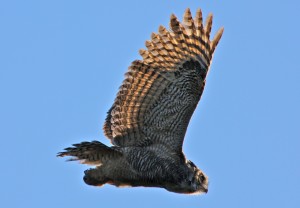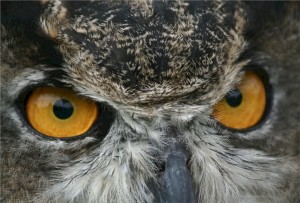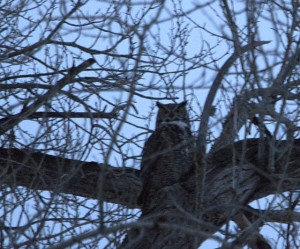Great Horned Owls
Caretaker Patty Reagin writes a monthly blog on the flora and fauna of the Wet Mountain Valley called “Spotted” for San Isabel Land Protection Trust (SILPT), the non-profit that holds the conservation easement for Humboldt Peak Ranch. This post is re-posted here courtesy of SILPT.
On cold, clear winter nights high in the Rocky Mountains, silence reigns. The brilliant crystal clarity of the stars cast soft shadows over the snow-covered landscape, and not even the faintest sigh of a breeze disrupts the utter stillness. On these nights, the quiet is only broken by the haunting call of the Great Horned Owl.
Easily recognizable, and common across the United States, Great Horned Owls are nonetheless a wonderful raptor to spot with their large golden eyes and familiar tufted ‘ears’ – actually just feathers sprouting from either side of their head. The actual ears of Great Horned Owls are located in the facial disks on either side of their face, and are slightly offset, causing sound to reach one ear slightly before the other. This allows the owls to not only determine the direction of a sound almost instantly, but also distance and height from the ground. These owls can easily locate prey moving underneath a foot of snow by sound alone, and it’s not only their hearing that is acute – they also have eyesight so sharp, they can see a mouse twitch from a football field away.
These majestic birds are largely crepuscular, meaning they prefer to hunt at dusk and dawn. Their bodies are covered in very soft feathers that keep them warm through the coldest of winters, and a fringe on the edges of their feathers acts as a very effective sound buffer, allowing them to fly in almost complete silence as they sneak up on an unsuspecting meal. More than once, we’ve followed the tracks of rabbits and other small mammals through the snow to an abrupt end, with a distinct impression of outstretched wings left in the snow beside them.
Fierce hunters, Great Horned Owls can easily take and carry prey much larger than themselves – including other raptors – due to exceptionally strong talons they use to sever the spine of their kill. Interestingly, because Great Horned Owls have no sense of smell, they are one of few predators to eat skunk.
December and January are the height of mating season for Great Horned Owls, and the deeper ‘hoo-hoo-hoooo-hoo-hoo” of the male is answered readily by a slightly higher timbre ‘hoo-hoo-hoooo-hoo-hoo’ of a willing female. A few nights ago as I was coming in from the barn at dusk I heard the owl’s call much closer than I usually do. Following the sound to the cottonwoods behind the house I found a pair of tufted ‘ears’ and golden eyes peering down at me from high on a tree branch. We stared at each other for a few minutes in the deepening twilight before the owl lifted off without a sound, floating over the adjacent snow-covered hay field to a waiting aspen.
 I stayed outside for awhile in the silence and watched a few stars appear, the owl’s silhouette regarding me from across the field, before I headed back inside to the warm fire waiting for me. As I walked into the house, I heard him call again, and this time I heard the female call back from deep in the woods. Maybe this spring we’ll find a nest full of tiny little Great Horned Owls.
I stayed outside for awhile in the silence and watched a few stars appear, the owl’s silhouette regarding me from across the field, before I headed back inside to the warm fire waiting for me. As I walked into the house, I heard him call again, and this time I heard the female call back from deep in the woods. Maybe this spring we’ll find a nest full of tiny little Great Horned Owls.